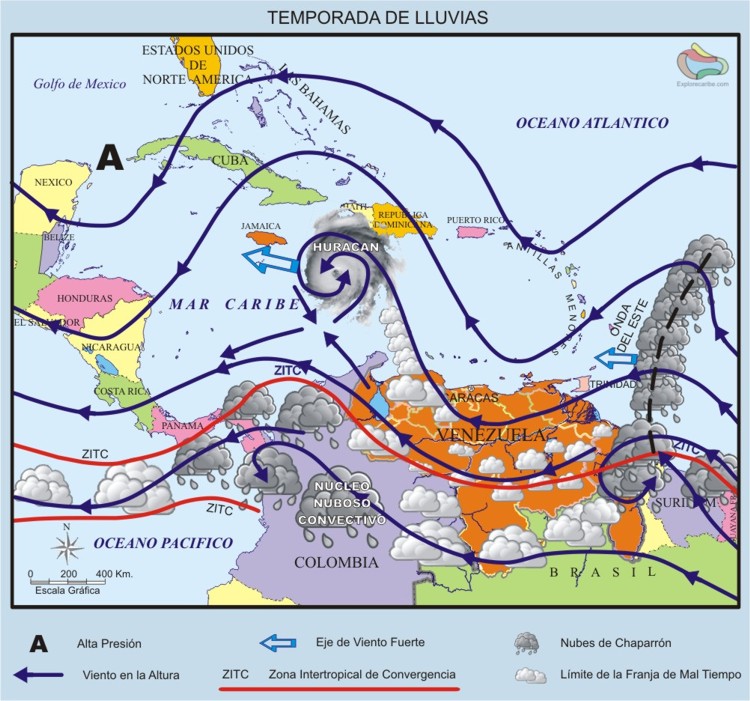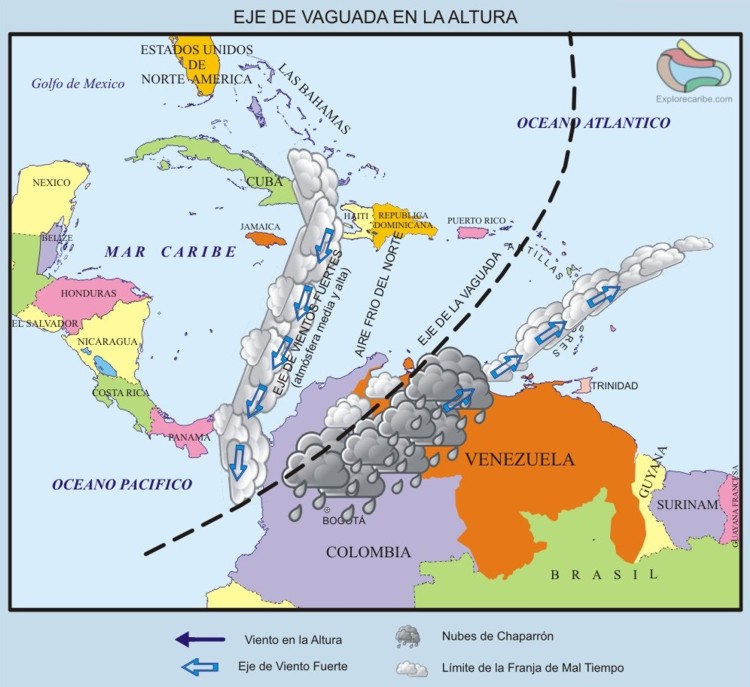The Caribbean Sea is located in the northern hemisphere of the intertropical zone of America, where the climate is characterized by its homogeneity, with an average annual temperature between 70-80°F, within a range of 35.6°F to 41°F. The important temperature changes occur throughout the day, which can range between 50 to 59°F with the coolest during the night and the hottest during the day.  Link to consult the current weather conditions of any place in the Caribbean Sea. Link to consult the current weather conditions of any place in the Caribbean Sea.
It is common in the caribbean that the meteorological conditions between zones are different; what can be generalized about climate is for being pleasant all the year around. In general, temperatures are moderate and the rainy season is well defined for each area. To be able to enjoy the caribbean climate you have to adapt and that is easily achieved by changing some behavior patterns. As something very important take into account is that during the hours when the sun is stronger (11 AM - 3 PM) you must protected from it, the time interval is greater towards the South and decreases towards the North. You also have to stay well hydrated and take advantage of those moments to take a nap and prepare for the coolest hours.
The most relevant feature of the caribbean climate is the Trade Winds  that is a constant breeze that softens the effects of the hot tropical sun. This is why the lands of Barlovento (where the wind comes from) will always have a cooler environment than the leeward ones (where the wind goes). This same pattern occurs with rainfall that in turn influences terrestrial ecosystems, especially where the topography is more rugged. that is a constant breeze that softens the effects of the hot tropical sun. This is why the lands of Barlovento (where the wind comes from) will always have a cooler environment than the leeward ones (where the wind goes). This same pattern occurs with rainfall that in turn influences terrestrial ecosystems, especially where the topography is more rugged.
In general, it can be said that any tropical and intertropical climate types are present in the Caribbean Sea. It can also be assured that the climate will be favorable to enjoy the infinite diversity of landscapes and environments that the caribbean offers. The rainy season can be violent when a tropical storm or even a hurricane hits any of the islands of the Antilles. They are so strong in some cases that the locals do their reference in relation to this events as occurring before or after one of these events.
The meteorological phenomena of the caribbean climate are very diverse due to the influence of many factors as the lower equatorial pressure, the intertropical convergence zone of the Trade Winds over the sea, tropical East waves, remains of cold fronts from the North, marine currents and the influence of its temperature causing among others things an excellent tropical climate refreshed by the breeze.
DRY SEASON
The tropical climate is characterized by two unique seasons well diferentiated, the wet and the dry. The dry season go from December to April or May of the next year.
In the Caribbean Sea the dry season is the cooler time of the year, the temperatures range between 82.1°F and 72,0°F. In general the average number of days with rain of this season are no more than 10, which are esporadics and short and all the average precipitation is no more the 2.8 inches.

RAINY SEASON
In the months of May, the equatorial low that penetrates the Caribbean along the north coast of South America, begins the rainy season that lasts until November. In the months of June to October is when rains appear on the islands closest to the coast of South America.

THALWEGS
Usually during the dry season a stream of cold air moves from the North, which may be moisture laden and driven by winds at medium and high altitude in the atmosphere. If this strem of cold air go down to the lower layers of the atmosphere and comes in contact with the warm air currents it may cause heavy rains that can extend for days in a specific area. This climatic phenomenon is known as Thalweg.
The consequences of the thalweg may reach catastrophic levels, as it is the case of the thalweg of 1999 on the central coast of Venezuela  . After a season of rains that saturated and soften the soil an increase of abnormal precipitation brings as a consequence the increase of the washing of the ground soil and the volume flow of the rivers. The force of the current takes the fine sediments that retain the big and small stones and these can be drag along with a lot of mud and other debris, this condition is potentially aggravated if the slope of the land is long and/or strong. . After a season of rains that saturated and soften the soil an increase of abnormal precipitation brings as a consequence the increase of the washing of the ground soil and the volume flow of the rivers. The force of the current takes the fine sediments that retain the big and small stones and these can be drag along with a lot of mud and other debris, this condition is potentially aggravated if the slope of the land is long and/or strong.

COLD FRONT
It occurs during the first months of the year.

|